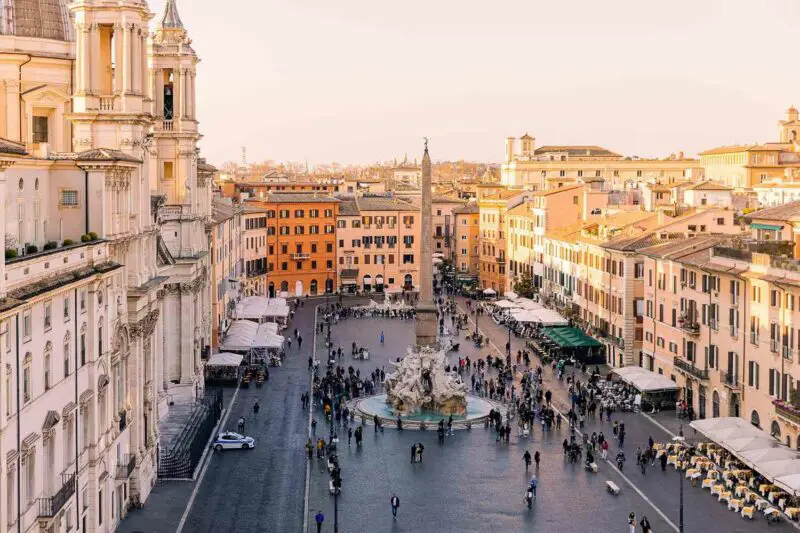When comparing the sizes of different countries, it’s fascinating to see how they stack up against one another. In this case, you might be interested in the size of Italy compared to the United States. Understanding the difference between them can give you a better appreciation of their unique geographical features and cultural landscapes.
Italy’s size is approximately 301,340 sq km, making it smaller in comparison to the United States, which covers an area of about 9,833,517 sq km. This means that the US is roughly 33 times larger than Italy. Although Italy is a relatively smaller country, you may find that its diverse landscapes and historic significance play an integral role in its global importance. Comparing the size of these two countries accentuates just how vast and geographically diverse our world truly is.
| Category | Italy | United States |
|---|---|---|
| Total Land Area | Approximately 301,340 sq km | Approximately 9,833,517 sq km |
| Water Area | Significant coastline along the Mediterranean Sea | Numerous lakes, rivers, and coastlines on both the Atlantic and Pacific Oceans |
| Territorial Waters | Extends 12 nautical miles from its coastline | Extends 12 nautical miles from its coastlines |
| Borders and Neighboring Countries | Shares borders with France, Switzerland, Austria, and Slovenia. Also surrounds Vatican City and San Marino | Shares borders with Canada (north) and Mexico (south) |
| Population | Approximately 61.1 million people | Approximately 337.3 million people |
| Population Density | About 201.6 people per square kilometer | About 33.7 people per square kilometer |
| Economy | Eighth-largest economy in the world with a GDP of approximately $2.1 trillion | World’s largest economy with a GDP of around $21.4 trillion |
Geographical Comparison
Total Land Area
When comparing the total land area of Italy and the United States, it’s evident that the two countries differ greatly in size. Italy covers approximately 301,340 sq km, while the United States spans over a much larger 9,833,517 sq km, making the US about 33 times larger than Italy.
Water Area
The water area in both countries also presents notable differences. Italy, being part of the Mediterranean region, has a significant coastline along the Mediterranean Sea. In contrast, the United States, situated in North America, boasts a much larger water area with numerous lakes, rivers, and coastlines on both the Atlantic and Pacific Oceans. The water area details for both nations contribute to their overall total surface area measurements.
Territorial Waters
Your country, Italy, has territorial waters extending 12 nautical miles from its coastline, as adhered to by most countries around the world. The United States also claims the same 12 nautical mile territorial waters extending from its coastlines.
Borders and Neighboring Countries
Italy, located in southern Europe on the Italian Peninsula, shares borders with several other European Union countries, including France, Switzerland, Austria, and Slovenia. Additionally, Italy entirely surrounds two independent states, Vatican City and San Marino. On the other hand, the United States shares borders solely with Canada to the north and Mexico to the south.
Terrain and Topography
The terrain in Italy and the United States varies significantly due to their contrasting geographical sizes and locations. Italy’s landscape mainly comprises mountainous regions, such as the Alps in the north, and vast plains, like those found in the Po Valley. The country also features beautiful coastlines along the Mediterranean Sea.
The United States, being much larger, showcases a diverse range of geographical features – from mountain ranges like the Rockies and the Appalachians to large plains, like the Great Plains, and scenic coastlines on both the east and west coasts, such as the beaches of California and the shores of San Diego. The country also has an abundance of water bodies, including massive lakes and extensive river systems.
By understanding these distinctions in geographical attributes, you can better appreciate the notable differences between Italy and the United States.

Statistical Comparison
Population
When comparing Italy to the United States, it’s important to note their population sizes. Italy is the 23rd largest country in the world with approximately 61.1 million people, whereas the United States has around 337.3 million people living within its borders, making it the third-largest country in terms of population.
Population Density
In terms of population density, Italy, being a relatively small country in Western Europe, has a significantly higher population density than the United States. You can observe this as you travel through Italy’s cities, such as Rome, as well as the countries surrounding Italy like France, Switzerland, Slovenia, Austria, and San Marino. The population density in Italy is about 201.6 people per square kilometer, while the United States has a much lower density of 33.7 people per square kilometer.
Economy
The Italian and United States economies have sizable differences. Italy has the eighth-largest economy in the world and the fourth-largest in the European Union, with a GDP (Gross Domestic Product) of approximately $2.1 trillion. The United States, on the other hand, boasts the world’s largest economy with a GDP of around $21.4 trillion.
Economically, Italy is known for its contributions to various sectors such as art, fashion, and cuisine, while the United States has a diverse and powerful economy with significant contributions in technology, manufacturing, and other domains.
Per Capita
Lastly, let’s discuss the per capita income of Italy and the United States. Italy’s GDP per capita is roughly $35,500, ranking 28th globally. Comparatively, the United States has a GDP per capita of about $65,100, making it the 11th highest globally. This difference in per capita income suggests that the average individual in the United States enjoys a higher standard of living than their Italian counterparts.
In summary, the United States is both geographically and economically larger than Italy, with a vastly greater population. However, Italy has a higher population density due, in part, to its smaller size and its location in Western Europe. It’s important to consider these differences when comparing life in the two countries.
Distinctive Features and Quality of Life
When comparing Italy and the United States, it’s important to consider the distinctive features and aspects of quality of life that each country has to offer.
Climate
Italy, situated in Southern Europe, enjoys a predominantly Mediterranean climate with hot summers and mild winters. Coastal areas like Rome enjoy a more temperate climate, while the northern regions near Switzerland, Austria, and Slovenia experience colder, alpine weather. On the other hand, the United States, being the third-largest country in the world, offers a diverse array of climates due to its vast scale. From the warm beaches of California to the snowy peaks of Colorado, you’ll find an environment that suits your preferences.
Art and Cultural Heritage
Italy is famously known for its rich art and cultural heritage, with cities like Rome, Florence, and Venice boasting countless historical sites, museums, and galleries. As the birthplace of the Renaissance, Italy has a profound impact on Western art and culture. In contrast, the United States has a shorter history, but it still offers its own unique blend of cultures and artistic expressions, from Native American art to modern pop culture and iconic cities like New York and Los Angeles.
Languages
The primary language spoken in Italy is Italian, although regional languages and dialects are prominent throughout the country. As a member of the European Union, English is also widely spoken, especially in urban areas and tourist destinations. In the United States, English is the most common language, but there is a significant population of Spanish speakers, as well as other languages spoken among diverse immigrant communities.
Religions
Italy, being predominantly Roman Catholic, has a deeply ingrained religious influence in its culture and tradition. The Vatican City, an independent city-state within Rome, serves as the spiritual center of the Catholic Church. The United States, on the other hand, is known for its religious diversity, with Christianity being the most widespread religion, but also a significant presence of Judaism, Islam, Hinduism, and a variety of other faiths. Religious freedom is a key value in the country, allowing for a rich tapestry of beliefs and practices.
By exploring these distinctive features and aspects of quality of life in Italy and the United States, you can better understand the similarities and differences between these two prominent countries positioned along the Mediterranean Sea and Western Europe.
Size Comparisons with Other Countries and Regions
Italy vs European Countries
Italy is the 10th largest country by land area in Europe, covering 116,350 square miles (301,340 square kilometers). In comparison to other European countries, Italy is about 0.28 times the size of Austria, 0.17 times as big as Bosnia and Herzegovina, and 0.37 times as big as Bulgaria. To put this in perspective, France (we compared France to the US) is around 2.1 times larger than Italy, while Monaco is less than 0.001 time the size of Italy.
Italy vs North American Countries
When comparing Italy to North American countries, the United States is approximately 32.5 times larger than Italy, with an area of 9,826,675 square kilometers. Even individual states within the United States can be significantly larger than Italy; for example, Texas is roughly twice the size of Italy, and Arizona is slightly larger than Italy. Among other North American countries, Mexico is about 5 times larger than Italy, while Canada, the second-largest country in the world, is over 28 times bigger than Italy.
Italy vs Asian and African Countries
In Asia, the largest continent, China leads in terms of size. China is nearly 36 times larger than Italy, while Russia is around 57 times bigger. Comparing Italy to African countries, Tunisia is about half the size of Italy, while the entire continent of Africa is around 30 times larger than Italy.
Italy vs South American Countries
Italy’s size can be compared to countries in South America like Brazil, which is the largest country in that continent and nearly 28 times bigger than Italy. In contrast, smaller South American countries like Portugal are about 10 times smaller than Italy.
Remember that size comparisons between countries can sometimes be distorted due to the Mercator projection. To accurately compare countries’ sizes, it is essential to use tools like The True Size Of or MapFight, which take into consideration the distortions and provide a more accurate representation.
FAQ
Italy is approximately 301,340 sq km, making it smaller in comparison to the United States, which covers an area of about 9,833,517 sq km. This means that the US is roughly 33 times larger than Italy.
Italy’s landscape mainly comprises mountainous regions, such as the Alps in the north, and vast plains, like those found in the Po Valley. The country also features beautiful coastlines along the Mediterranean Sea. The United States, being much larger, showcases a diverse range of geographical features – from mountain ranges like the Rockies and the Appalachians to large plains, like the Great Plains, and scenic coastlines on both the east and west coasts.
Italy has approximately 61.1 million people, whereas the United States has around 337.3 million people living within its borders, making it the third-largest country in terms of population.
- What Size is Regular Printer Paper? Quick Guide for Paper Dimensions - June 18, 2023
- What Size is My Monitor: A Comprehensive Guide - June 18, 2023
- How Big is Italy Compared to the US? A Concise Comparison - June 16, 2023

